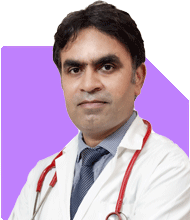62-Year-Old Woman Seeking Financial Advice for Retirement Portfolio
Ramalingam Kalirajan |6715 Answers |Ask -Follow
Mutual Funds, Financial Planning Expert - Answered on Oct 21, 2024
He has an MBA in finance from the University of Madras and is a certified financial planner.
He is the director and chief financial planner at Holistic Investment, a Chennai-based firm that offers financial planning and wealth management advice.... more

Sir...i am 62 years and my husband is 67...our monthly expense is 45k..my husband does 30 k charity every month..he gets pension of 30k and interest of fdr of 30k..i hv invested 75 lakhs in fdr and 40 lakhs in annuity..60k in sr citizen scheme..i receive monthly 80k from fds and annuity and 60k in qrtly interest..my insurance in mediclaim is for 35 lakhs together in floater policy. Any suggestion for improvement in my portfolio
Currently, your monthly expenses are Rs 45,000, with Rs 30,000 dedicated to charity. You have a reliable income of Rs 30,000 from your husband's pension and Rs 80,000 monthly from FDs and annuities, plus Rs 60,000 in quarterly interest. This means you have sufficient income to cover your expenses and charity commitments comfortably.
However, there is always room for improvement in managing financial portfolios, especially when planning for long-term sustainability, tax efficiency, and diversification.
Review of Investments and Income Sources
You have Rs 75 lakhs invested in Fixed Deposits (FDs), Rs 40 lakhs in an annuity, and Rs 60,000 in the Senior Citizen Savings Scheme (SCSS). These investments are solid, but there are potential areas for enhancement.
Fixed Deposits: FDs are a safe investment, but they often yield lower returns compared to other instruments like debt mutual funds. The interest earned from FDs is taxable as per your slab, which can eat into the returns. You may want to consider diversifying part of this into mutual funds that are more tax-efficient.
Annuity: While annuities provide a stable income stream, they often lock your money and may not offer high returns. You might want to reconsider this in light of other more flexible options that could offer better returns.
Senior Citizen Savings Scheme (SCSS): The SCSS is an excellent, safe investment option for retirees. The quarterly interest payout helps manage regular expenses. However, this too is taxable, so exploring tax-efficient alternatives is worth considering.
Consideration of Taxation
One major factor affecting your portfolio is taxation. The interest from FDs, annuities, and SCSS is fully taxable under your income tax slab. This reduces your effective returns. Here’s what you could do to optimize taxation:
Debt Mutual Funds: These funds have a more favorable tax treatment compared to FDs. Gains from debt funds, if held for more than three years, are taxed at a lower rate due to indexation benefits. This could significantly increase your post-tax returns, especially when compared to the taxable interest from FDs.
Equity Mutual Funds: Though you currently seem to have avoided equity investments, a small allocation in equity mutual funds can boost your returns. Equity investments are taxed more efficiently, with long-term capital gains (LTCG) above Rs 1.25 lakh taxed at 12.5%. This tax advantage can help build wealth for the long term.
Risk and Diversification
Your portfolio is heavily skewed towards safe, fixed-income instruments. While safety is important, especially at this stage of life, having all investments in such instruments may not give you the inflation-beating growth you need over the long term. With inflation eroding the purchasing power of money, it is essential to include growth-oriented assets in your portfolio, even if it’s a small portion.
Equity Mutual Funds for Growth: A balanced mutual fund with some exposure to equities will help generate higher returns, especially for the longer term. Since you do not need all your income right away, you could consider investing a portion of your assets in a well-managed, actively balanced mutual fund.
Avoid Over-Concentration in FDs: While FDs are safe, over-reliance on them can limit your portfolio’s growth. Shifting some of your funds to other safer debt mutual funds or balanced funds would provide better tax efficiency and returns.
Health Insurance Adequacy
Your floater mediclaim policy for Rs 35 lakhs is good, but it’s important to review if this amount is adequate. Healthcare costs are rising, and having an adequate health cover is crucial at your age.
Review Health Coverage: Consider whether Rs 35 lakhs will cover both of you in case of a medical emergency. Medical costs, particularly for senior citizens, can escalate quickly, and an inadequate cover could eat into your retirement corpus. You may want to explore top-up plans to enhance your existing cover at a low additional cost.
Charitable Contributions
Your monthly charity contributions of Rs 30,000 show your generosity and commitment to social causes. However, it’s important to assess how this affects your overall financial sustainability.
Sustainable Charity: Consider setting aside a specific fund or investment that generates income solely for charitable purposes. For instance, you could invest in tax-efficient mutual funds and use the returns to support your charity. This way, your contributions are sustainable without affecting your long-term financial security.
Contingency Planning
At this stage, you should ensure that you have an adequate contingency plan in place. While your current income seems to cover your expenses comfortably, it is essential to have liquidity for any unforeseen medical or personal emergencies.
Maintain Liquidity: Keep a portion of your Rs 75 lakh FDs or the Rs 60,000 SCSS in a liquid fund or savings account to ensure easy access in case of an emergency. This provides a buffer without having to liquidate long-term investments.
Estate Planning
Given your current age, it is also time to think about estate planning. Ensuring that your assets are passed on smoothly to your beneficiaries is an important step.
Create a Will: If you haven’t already, consider drafting a will to ensure that your assets are distributed according to your wishes. This reduces the legal complications for your family.
Final Insights
To summarize, here are a few suggestions to optimize your portfolio:
Diversify Investments: Consider shifting some funds from FDs into more tax-efficient debt or balanced mutual funds to enhance returns and manage taxes better.
Review Annuity: Reevaluate the portion of your portfolio invested in annuities and consider whether there are more flexible options available.
Tax Efficiency: Focus on reducing the tax burden from your interest income by exploring mutual funds that offer better post-tax returns.
Health Cover: Ensure your health insurance coverage is adequate for both of you, considering the rising costs of healthcare.
Sustainable Charity: Consider creating a sustainable charity fund by investing in mutual funds that generate returns specifically for charity purposes.
Estate Planning: Ensure you have a will in place for smooth estate transfer and to protect your legacy.
These steps will ensure that your portfolio is better balanced, tax-efficient, and aligned with your future financial goals. You have built a solid foundation, but with a few adjustments, you can further strengthen your financial security.
Best Regards,
K. Ramalingam, MBA, CFP,
Chief Financial Planner,
www.holisticinvestment.in
https://www.youtube.com/@HolisticInvestment
You may like to see similar questions and answers below
Ramalingam Kalirajan |6715 Answers |Ask -Follow
Mutual Funds, Financial Planning Expert - Answered on May 13, 2024
Ramalingam Kalirajan |6715 Answers |Ask -Follow
Mutual Funds, Financial Planning Expert - Answered on May 11, 2024
Ramalingam Kalirajan |6715 Answers |Ask -Follow
Mutual Funds, Financial Planning Expert - Answered on Jun 07, 2024
Ramalingam Kalirajan |6715 Answers |Ask -Follow
Mutual Funds, Financial Planning Expert - Answered on Jul 25, 2024
Milind Vadjikar |478 Answers |Ask -Follow
Insurance, Stocks, MF, PF Expert - Answered on Oct 21, 2024
Milind Vadjikar |478 Answers |Ask -Follow
Insurance, Stocks, MF, PF Expert - Answered on Oct 21, 2024
Dr Chandrakant Lahariya |50 Answers |Ask -Follow
Diabetologist, Consultant Physician, Vaccine Expert - Answered on Oct 21, 2024
Dr Chandrakant Lahariya |50 Answers |Ask -Follow
Diabetologist, Consultant Physician, Vaccine Expert - Answered on Oct 21, 2024
Anu Krishna |1226 Answers |Ask -Follow
Relationships Expert, Mind Coach - Answered on Oct 21, 2024
Milind Vadjikar |478 Answers |Ask -Follow
Insurance, Stocks, MF, PF Expert - Answered on Oct 21, 2024
Anu Krishna |1226 Answers |Ask -Follow
Relationships Expert, Mind Coach - Answered on Oct 21, 2024
Moneywize |170 Answers |Ask -Follow
Financial Planner - Answered on Oct 21, 2024
Anu Krishna |1226 Answers |Ask -Follow
Relationships Expert, Mind Coach - Answered on Oct 21, 2024
Anu Krishna |1226 Answers |Ask -Follow
Relationships Expert, Mind Coach - Answered on Oct 21, 2024










.jpg)














